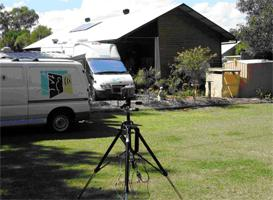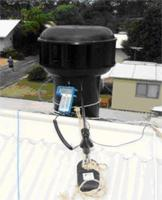Or as they are generically known in Australia whirlybirds. The term whirlybird was first registered in USA as a Trade Mark by G & S Turbine Ventilators in 1981, the owner of the Trade Mark is now Lomanco Incorporated of Arkansas USA Reg No 1177089. Whirly roof vents whatever they are known by are all actually turbine ventilators, do they really work?
Not if you consider the following report done by Deakin University’s state of the art testing equipment.

Testing for sala homes 2008.
As you may know, MABEL is the most versatile and comprehensive in-situ testing facility for built internal environments throughout Australia. MABEL is a diagnostic toolkit providing multi-dimensional testing of the key performance criteria of energy, light, sound, and comfort.
MABEL Scope of Project
The Mobile Architecture and Built Environment Laboratory (MABEL) was called upon to investigate the overall comfort and natural passive (mechanical) systems of the SALA Home prototype. The intention was to uncover information on the built environment performance and to highlight ‘fault finding’ instances within the systems and construction provided to the overall house design. MABEL is the most versatile and comprehensive in-situ testing facility for the built internal environment. It is a diagnostic toolkit that provides multi-dimensional assessment of key performance criteria in built environments covering energy, sound, light and comfort. Comfort is inclusive of ventilation and air quality investigations.

Testing the Roof Ventilation System
The Roof Ventilation System comprises of two rotating Wind Turbines set on top of short pieces of ductwork. The manufacturer’s belief is that the wind turbine will expel air in the same manner as a centrifugal fan when it is spinning. However a wind turbine is not a centrifugal fan and does not move air, but is instead moved by the air. This is a fundamental fact not understood by the manufacturers of these products.

With a 300 mm duct installed, with the air velocities measured (see below) a calculated flow rate of 70 litres per second per ventilator is achieved. This equates to a flow velocity of approximately 0.1 metres per second in the wall cavities and the roof. This is considered to be still air in ventilation terms, and is totally inadequate to remove any heat load from the walls and roof.
Recommendations and Conclusions
A more effective roof cavity ventilation system requires further exploration.
Universal Tile Ventilators "Smoothline" ventilators were chosen as SALA Homes preferred ventilation systems.
This testing was done to test the efficiency of eco homes in Queensland turbine vents were one of parts of the home that they hoped would show some efficiency in energy costs.
If you are looking for efficient roof space ventilation Universal Tile Ventilators for tiled roofs and our Smoothline ventilator for corrugated colorbond roofs is the answer to effective roof ventilation. With inlets and outlets in the roof covering, they are aerodynamically designed to harness all the principles of fluid dynamics and will take whatever Mother Nature has to throw at them. You can’t beat that.
